
Austromyrtus is a genus of shrubs in the myrtle family Myrtaceae. Three species are found along the east coast of Australia; in Queensland and in New South Wales and A. lotoides being endemic to New Caledonia. The fruits of A. dulcis have a hint of cinnamon flavouring. The species under this generic name in New Caledonia are being taxonomically revised and will be transferred to another genus.

Hakea salicifolia commonly known as the willow-leaved hakea, is species of flowering plant that is endemic to eastern Australia. It is an adaptable, fast growing small tree or shrub with attractive foliage and cream white flowers.
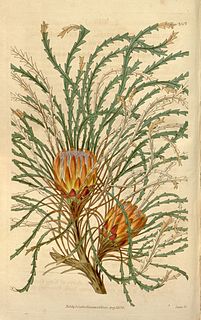
Banksia tenuis is a species of shrub that is endemic to the southwest of Western Australia. It has pinnatifid, serrated or smooth-edges leaves, golden brown and cream-coloured flowers in heads of about fifty-five and glabrous, egg-shaped follicles.
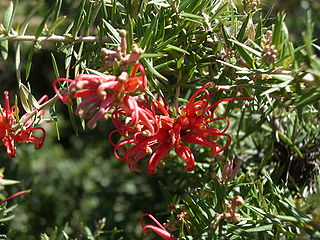
Grevillea juniperina, commonly known as juniper- or juniper-leaf grevillea or prickly spider-flower, is a plant of the family Proteaceae native to eastern New South Wales and southeastern Queensland in Australia. Scottish botanist Robert Brown described the species in 1810, and seven subspecies are recognised. One subspecies, G. j. juniperina, is restricted to Western Sydney and environs and is threatened by loss of habitat and housing development.
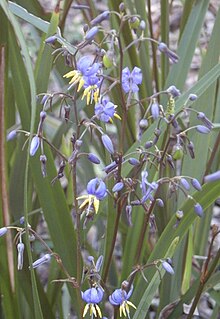
Dianella caerulea, commonly known as the blue flax-lily, blueberry lily, or paroo lily, is a perennial herb of the family Asphodelaceae, subfamily Hemerocallidoideae, found across the eastern states of Australia and Tasmania. It is a herbaceous strappy perennial plant to a metre high, with dark green blade-like leaves to 70 cm long. Blue flowers in spring and summer are followed by indigo-coloured berries. It adapts readily to cultivation and is commonly seen in Australian gardens and amenities plantings.

Trachymene is a genus of herbaceous plants in the family Araliaceae. The species are native to Australia, Malesia, New Caledonia and Fiji.
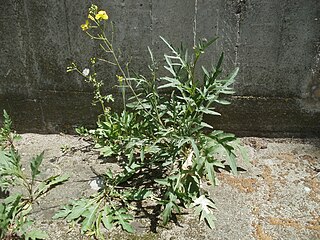
Diplotaxis tenuifolia is a species of flowering plant in the mustard family known by the common names wild rocket and perennial wall-rocket. This plant is native to Europe and West Asia. It can be found throughout much of the temperate world where it has naturalized.

Austromyrtus dulcis is a species of plant native to eastern Australia. it grows as a small spreading shrub and is easily recognised by its characteristic berries that usually ripen in summer and autumn. Common names include the midgen berry, midyim, and silky myrtle.

Grevillea oldei is a shrub which is endemic to New South Wales in Australia.

Caustis flexuosa is a sedge found in Australia. A graceful plant with attractive curling foliage, it grows to 120 cm high. Common names include curly wig and grandfather's beard.

Actinotus minor, commonly known as the lesser flannel flower, is species of flowering plant in the family Apiaceae and is endemic to New South Wales. It is a small, sprawling plant with grey-green leaves and white flowers.
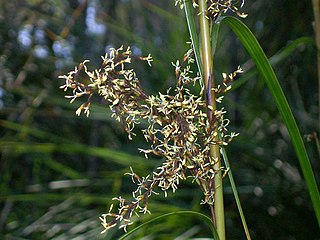
Gahnia melanocarpa, known as the black fruit saw-sedge, is a tussock forming perennial plant in eastern Australia. Often found in the wetter forests or in rainforest margins, it is common on the coast but also seen in the tablelands.

Lomatia myricoides, commonly known as the river lomatia, is a shrub native to New South Wales and Victoria in southeastern Australia.

Grevillea stenobotrya is a shrub or small tree in the family Proteaceae that is endemic to arid regions of Australia. Common names include rattle-pod grevillea, sandhill grevillea, sandhill oak and sandhill spider flower.

Agalinis tenuifolia, known by the common names common gerardia, slender false foxglove or common false foxglove, is an annual forb native to the eastern and southwestern United States, and Canada, which produces purple flowers in late summer or early fall.
Iris loczyi is a beardless iris in the genus Iris, in the subgenus Limniris and in the series Tenuifoliae of the genus. It is a rhizomatous herbaceous perennial, from a wide area of Asia, including Afghanistan, Iran, Kazakhstan, Tajikistan, Mongolia, Tibet and China. It has long thin grey green leaves, long stems and 1 flower in pale violet, blue violet, lavender or light blue.
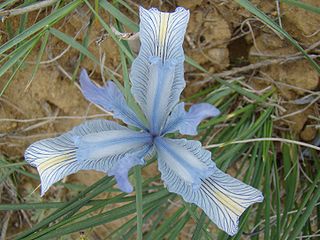
Iris tenuifolia is a beardless iris in the genus Iris, in the subgenus Limniris and in the series Tenuifoliae of the genus. It is a rhizomatous herbaceous perennial, from a wide region over central Asia, including Afghanistan, Pakistan, ; Kazakhstan, Uzbekistan and Mongolia and in China. It has long greyish-green leaves, short stem and pale violet, lilac, pale blue, or purple flowers.

Persoonia tenuifolia, commonly known as fine-leaf geebung is a plant in the family Proteaceae and is endemic to eastern Australia. It is an erect to low-lying shrub with hairy young branchlets, linear leaves, and yellow flowers in groups of up to eight on a rachis 2–30 mm (0.079–1.181 in) long that continues to grow after flowering.

Psychotria tenuifolia, commonly known as velvet-leaved wild coffee, is a species of plant in the family Rubiaceae. It is endemic to southern Florida, South America and the Caribbean. The description of velvet is based on the silky appearance that the leaves display in relation to other species of the same plant family.

Olearia tenuifolia, commonly known as the thin-leaf daisy-bush, is a small shrub with narrow leaves and clusters of blue, deep mauve to purple flowers.



















